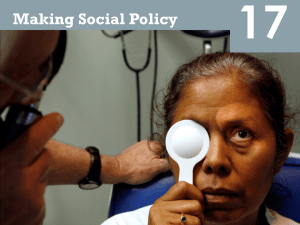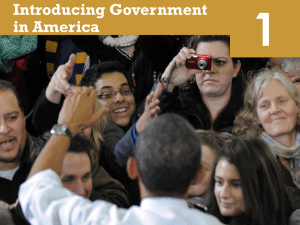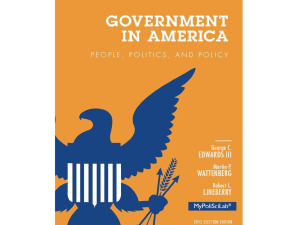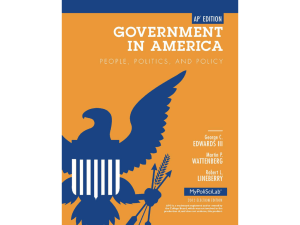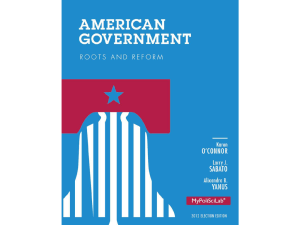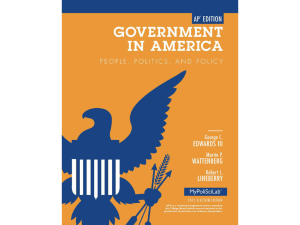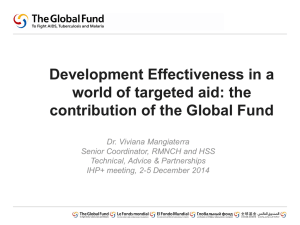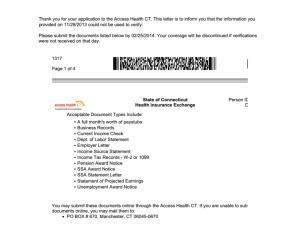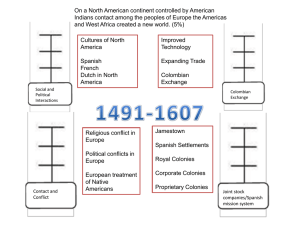clientimages/28102/moseleyd/ap government chapter 17
advertisement
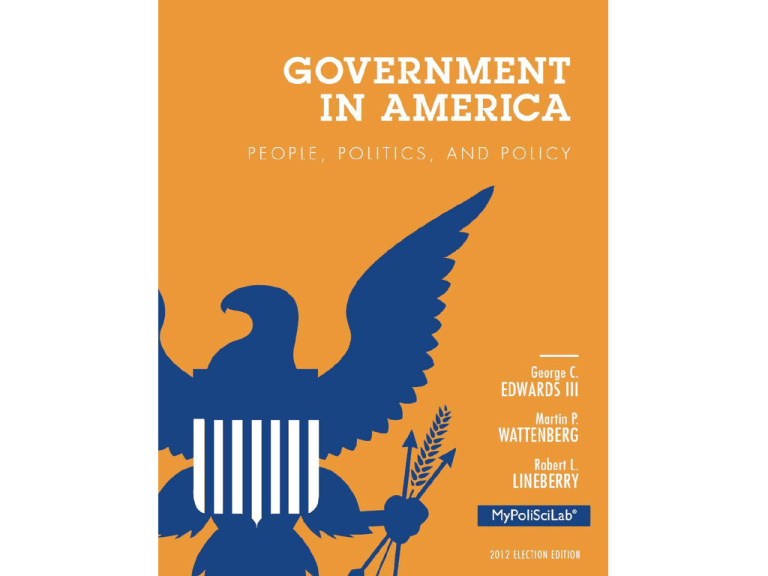
Policymaking for Health Care, the Environment, and Energy 17 Video: The Big Picture 17 http://media.pearsoncmg.com/ph/hss/SSA_SHARED_MED IA_1/polisci/presidency/Edwards_Ch17_Policymaking_for_ Health_Care_Seg1_v2.html Learning Objectives 17.1 17.2 17 Outline the problems of health care in America and the role of government in health care Analyze the conflicts between economic growth and environmental protection, and identify the major national environmental protection policies Learning Objectives 17.3 17.4 17 Evaluate the advantages and disadvantages of each of the principal sources of energy in the United States Assess the role of democratic politics in making health care, environmental, and energy policy and the effect of these policies on the scope of government Video: The Basics 17 http://media.pearsoncmg.com/ph/hss/SSA_SHARED_MED IA_1/polisci/presidency/Seg2_SocialPolicy_v2.html Health Care Policy Cost of Health Care Access to Health Care Role of Government in Health Care Reform Efforts 17.1 Cost of Health Care 17.1 $2.8 trillion per year 19% of GDP Spends most, covers least All other developed countries have universal health care ¼ of federal budget Why spending so high? Incentives No single payer Competition Access to Health Care Quality of care varies How do Americans access health care? Private insurance (2/3) HMOs (over half) Medicare (65 and older) Medicaid (poor people) CHIP (poor children) 17.1 Access to Health Care The uninsured 50 million (16%) 7 million children (10%) 10 million aged 18-25 No group rate 17.1 Access to Health Care Insurance link with jobs a quirk 55% insured through employer Lack of preventative care Higher risk of dying for uninsured 17.1 FIGURE 17.1: The rising cost of health care 17.1 Access to Health Care 17.1 Disparities + cost = difficult policy decisions Prevention or treatment? Rationing of care Denial of care to loved ones Insurance plan limits Disparities in health care access 17.1 Role of Government in Health Care Government pays for 42% of health care Tax breaks to employers Public hospitals NIH-funded research Armed forces 17.1 Role of Government in Health Care Medicare (1965) 50 million (16%) $534 billion (14% of federal budget) 17.1 Role of Government in Health Care Medicaid (1965) 50 million (16%) $300 billion fed/$130 billion states 17.1 Reform Efforts National health insurance Opposed by AMA “Socialized medicine” Bill Clinton Tried to tackle cost and access Resounding failure 17.1 Reform Efforts Barack Obama Weak bill passed: Affordable Care Act (2010) Insurance industry retains power Mandate upheld by Supreme Court 17.1 President Obama’s health care reform 17.1 Explore Social Policy: Is Health Care a Public Good? 17.1 http://media.pearsoncmg.com/long/long_edwards_mpslgi a_16/pex/pex17.html 17.1 What government health care program covers people over age 65? a. Medicaid b. Social Security c. Medicare d. CHIP 17.1 17.1 What government health care program covers people over age 65? a. Medicaid b. Social Security c. Medicare d. CHIP 17.1 Explore the Simulation: You Are an OMB Staff Member 17.1 http://media.pearsoncmg.com/long/long_longman_media _1/2013_mpsl_sim/simulation.html?simulaURL=19 Video: In Context 17.1 http://media.pearsoncmg.com/ph/hss/SSA_SHARED_MED IA_1/polisci/presidency/Seg3_SocialPolicy_v2.html Environmental Policy Economic Growth and the Environment Environmental Policies in America Global Warming 17.2 Economic Growth and the Environment Environment v. jobs Pollution inevitable byproduct of growth? Environmental movement of 1960s Explosion of environmental groups Science/growth of support Backlash 17.2 2010 BP oil spill 17.2 Environmental Policies in America EPA (1970) Environmental impacts NEPA (1969) Govt. agencies must file statements Clean Air Act of 1970 17.2 Environmental Policies in America Water Pollution Control Act of 1972 Wilderness preservation Endangered Species Act of 1973 17.2 Environmental Policies in America Toxic Wastes Superfund Nuclear Waste 17.2 Global Warming Potential effects Sea level rise Severe weather Shift in agricultural zones 17.2 Polar bear and global warming 17.2 Global Warming Meeting in Rio in 1992 Set goals to reduce greenhouse gas Followed up in Kyoto in 1997 U.S. refused to agree to reduced emissions 17.2 Global Warming Developed v. developing countries Skeptics 17.2 17.2 Why is it difficult to get 17.2 polluters to pay for clean-up of Superfund sites? a. Many polluting companies have gone out of business b. Polluters from 60 years ago are difficult to trace c. Litigation over liability can last for many years d. All of the above 17.2 Why is it difficult to get 17.2 polluters to pay for clean-up of Superfund sites? a. Many polluting companies have gone out of business b. Polluters from 60 years ago are difficult to trace c. Litigation over liability can last for many years d. All of the above Video: Thinking Like a Political Scientist 17.2 http://media.pearsoncmg.com/ph/hss/SSA_SHARED_MED IA_1/polisci/presidency/Seg4_SocialPolicy_v2.html Energy Policy Coal Petroleum and Natural Gas Nuclear Energy Renewable Sources of Energy 17.3 Coal, Petroleum, and Natural Gas Coal 90% of fuel reserves 21% of energy/50% of electricity Dirtiest fuel Petroleum 36% of energy/automobiles 50% imported Natural gas 25% of energy 17.3 FIGURE 17.2: Sources of America’s energy 17.3 FIGURE 17.3: Importing petroleum 17.3 Nuclear Energy and Renewable Sources of Energy Nuclear energy 20% of energy Safety concerns Renewable sources of energy 8% Water, wind, sun, geothermal, biomass 17.3 17.3 Which fuel source provides the greatest percentage of U.S. energy? a. Petroleum b. Renewable energy c. Coal d. Nuclear 17.3 17.3 Which fuel source provides the greatest percentage of U.S. energy? a. Petroleum b. Renewable energy c. Coal d. Nuclear 17.3 Understanding Health Care, Environmental, and Energy Policy Democracy, Health Care, and Environmental Policy Scope of Government and Health Care, Environmental, and Energy Policy 17.4 Democracy, Health Care, and Environmental Policy Technologically complex decisions Can citizens participate effectively? Democracy is a messy business Ill-informed opinions Interest groups help 17.4 Scope of Government and Health Care, Environmental, and Energy Policy 17.4 Scope of government expanded in health care policy Medicare and Medicaid Tax breaks to employers Yet system is mostly private Environmental protection has expanded federal government 17.4 How is the U.S. health care 17.4 system unique? a. It costs less than systems in other countries b. It provides fewer doctors per capita than in other countries c. It is mostly private rather than public d. None of the above 17.4 How is the U.S. health care 17.4 system unique? a. It costs less than systems in other countries b. It provides fewer doctors per capita than in other countries c. It is mostly private rather than public d. None of the above Video: In the Real World 17.4 http://media.pearsoncmg.com/ph/hss/SSA_SHARED_MED IA_1/polisci/presidency/Seg5_SocialPolicy_v2.html Discussion Question What are some of the controversies and trade-offs involved in environmental policymaking? 17 Video: So What? 17 http://media.pearsoncmg.com/ph/hss/SSA_SHARED_MED IA_1/polisci/presidency/Edwards_Ch17_Policymaking_for_ Health_Care_Seg6_v2.html Further Review: On MyPoliSciLab Listen to the Chapter Study and Review the Flashcards Study and Review the Practice Tests 17
